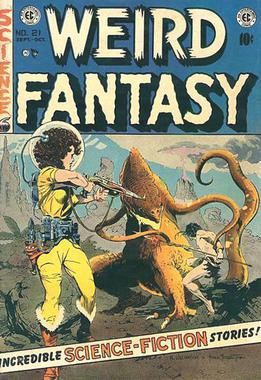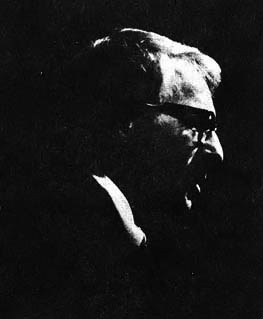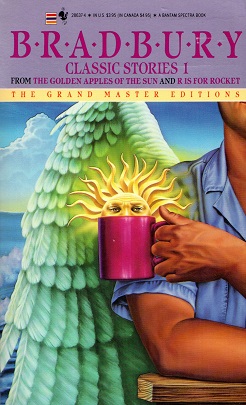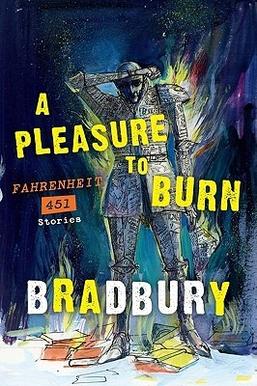Related Research Articles

Mars, the fourth planet from the Sun, has appeared as a setting in works of fiction since at least the mid-1600s. Trends in the planet's portrayal have largely been influenced by advances in planetary science. It became the most popular celestial object in fiction in the late 1800s, when it became clear that there was no life on the Moon. The predominant genre depicting Mars at the time was utopian fiction. Around the same time, the mistaken belief that there are canals on Mars emerged and made its way into fiction, popularized by Percival Lowell's speculations of an ancient civilization having constructed them. The War of the Worlds, H. G. Wells's novel about an alien invasion of Earth by sinister Martians, was published in 1897 and went on to have a major influence on the science fiction genre.

Ray Douglas Bradbury was an American author and screenwriter. One of the most celebrated 20th-century American writers, he worked in a variety of genres, including fantasy, science fiction, horror, mystery, and realistic fiction.

The Martian Chronicles is a science fiction fix-up novel, published in 1950, by American writer Ray Bradbury that chronicles the exploration and settlement of Mars, the home of indigenous Martians, by Americans leaving a troubled Earth that is eventually devastated by nuclear war.

The Illustrated Man is a 1951 collection of 18 science fiction short stories by American writer Ray Bradbury. A recurring theme throughout the stories is the conflict of the cold mechanics of technology and the psychology of people. It was nominated for the International Fantasy Award in 1952.

Leigh Douglass Brackett was an American science fiction writer known as "the Queen of Space Opera." She was also a screenwriter, known for The Big Sleep (1946), Rio Bravo (1959), and The Long Goodbye (1973). She worked on an early draft of The Empire Strikes Back (1980), elements of which remained in the film; she died before it went into production. In 1956, her book The Long Tomorrow made her the first woman ever shortlisted for the Hugo Award for Best Novel, and, along with C. L. Moore, one of the first two women ever nominated for a Hugo Award. In 2020, she posthumously won a Retro Hugo for her novel The Nemesis From Terra, originally published as "Shadow Over Mars".

R Is for Rocket (1962) is a short story collection by American writer Ray Bradbury, compiled for Young Adult library sections. It contains fifteen stories from earlier Bradbury collections, and two previously uncollected stories.

The Golden Apples of the Sun is an anthology of 22 short stories by American writer Ray Bradbury. It was published by Doubleday & Company in 1953.

The planet Venus has been used as a setting in fiction since before the 19th century. Its opaque cloud cover gave science fiction writers free rein to speculate on conditions at its surface—a "cosmic Rorschach test", in the words of science fiction author Stephen L. Gillett. The planet was often depicted as warmer than Earth but still habitable by humans. Depictions of Venus as a lush, verdant paradise, an oceanic planet, or fetid swampland, often inhabited by dinosaur-like beasts or other monsters, became common in early pulp science fiction, particularly between the 1930s and 1950s. Some other stories portrayed it as a desert, or invented more exotic settings. The absence of a common vision resulted in Venus not developing a coherent fictional mythology, in contrast to the image of Mars in fiction.

Weird Fantasy is an American dark fantasy and science fiction anthology comic that was part of the EC Comics line in the early 1950s. The companion comic for Weird Fantasy was Weird Science. Over a four-year span, Weird Fantasy ran for 22 issues, ending with the November–December 1953 issue.

The Vintage Bradbury (1965) was the first "best of" collection of the stories of Ray Bradbury, as selected by the author. It was published by Vintage Books, a paperback division of Random House.

The Stories of Ray Bradbury is an anthology containing 100 short stories by American writer Ray Bradbury, first published by Knopf in 1980. The hundred stories, written from 1943 to 1980, were selected by the author himself. Bradbury's work had previously been collected in various compilations, such as The Martian Chronicles and The October Country, but never in such a large volume or spanning such a long period of time.
"There Will Come Soft Rains" is a science fiction short story by author Ray Bradbury written as a chronicle about a lone house that stands intact in a California city that has otherwise been obliterated by a nuclear bomb, and then is destroyed in a fire caused by a windstorm. The title is from a 1918 poem of the same name by Sara Teasdale that was published during World War I and the Spanish flu pandemic. The story was first published in 1950 in two different versions in two separate publications, a one-page short story in Collier's magazine and a chapter of the fix-up novel The Martian Chronicles.
"The Pedestrian" is a science fiction short story by American writer Ray Bradbury. This story was originally published in the August 7, 1951 issue of The Reporter by The Fortnightly Publishing Company. It is included in the collection The Golden Apples of the Sun (1953), but was dropped from later editions of this collection.

The following is a list of works by Ray Bradbury.

Classic Stories 1: From The Golden Apples of the Sun and R is for Rocket is a semi-omnibus edition of two short story collections by Ray Bradbury: The Golden Apples of the Sun (1953) and R is for Rocket (1962).
The following is a list of works by Arthur C. Clarke.

The Illustrated Man is a 1969 American dark science fiction drama film directed by Jack Smight and starring Rod Steiger as a man whose tattoos on his body represent visions of frightening futures. The film is based on three short stories from the 1951 collection The Illustrated Man by Ray Bradbury: "The Veldt," "The Long Rain," and "The Last Night of the World."
"The Rocket" is a science fiction short story by American writer Ray Bradbury. It is also included in The Illustrated Man, a collection of short stories by Ray Bradbury.

A Pleasure to Burn: Fahrenheit 451 Stories is a collection of short stories by American writer Ray Bradbury, first published August 17, 2010. A companion to novel Fahrenheit 451, it was later released under the Harper Perennial imprint of HarperCollins publishing was in 2011.

Futuria Fantasia was an American science fiction fanzine created by Ray Bradbury in 1938, when he was 18 years old. Though only four issues of the fanzine were published, its list of contributors included Hannes Bok, Forrest J. Ackerman, Henry Kuttner, Damon Knight, and Robert A. Heinlein.
References
- 1 2 Reid, Robin Anne (2000). Ray Bradbury: A Critical Companion. Greenwood Publishing Group. pp. 45–. ISBN 9780313309014 . Retrieved 18 December 2012.
- 1 2 Stableford, Brian M. (2006). "Venus". Science Fact and Science Fiction: An Encyclopedia . CRC Press. pp. 548–. ISBN 9780415974608 . Retrieved 18 December 2012.
- 1 2 Eller, Jonathan R. (2011-08-04). Becoming Ray Bradbury. University of Illinois Press. pp. 262–. ISBN 9780252036293 . Retrieved 18 December 2012.
- ↑ Eller, Jonathan R.; Touponce, William F. (2004). Ray Bradbury: The Life of Fiction . Kent State University Press. pp. 480–. ISBN 9780873387798 . Retrieved 18 December 2012.
- ↑ Bradbury, Ray (1997-11-01). Golden Apples of the Sun, The. HarperCollins. ISBN 9780380730391 . Retrieved 18 December 2012.
- ↑ Bradbury, Ray (2005-04-05). Bradbury Stories: 100 of His Most Celebrated Tales . HarperCollins. ISBN 9780060544881 . Retrieved 18 December 2012.
- ↑ Fletcher, Ralph (2012-07-03). Guy-Write: What Every Guy Writer Needs to Know. Macmillan. pp. 51–. ISBN 9781429955270 . Retrieved 18 December 2012.
- ↑ Grinspoon, David Harry (1998). Venus Revealed: A New Look Below the Clouds of Our Mysterious Twin Planet. Basic Books. pp. 31–. ISBN 9780201328394 . Retrieved 18 December 2012.
- ↑ Johnson, Wayne L. (1980). Ray Bradbury . F. Ungar Publishing Company. ISBN 9780804424264 . Retrieved 18 December 2012.
- 1 2 Weller, Sam (2006-02-21). The Bradbury Chronicles: The Life of Ray Bradbury. HarperCollins. pp. 280–. ISBN 9780060545840 . Retrieved 18 December 2012.
- ↑ "The Ray Bradbury Theater - The Long Rain (1992) - Full cast and crew". Internet Movie Database . Retrieved 18 December 2012.